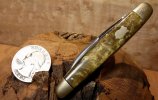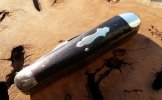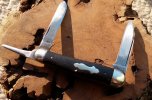-
The BladeForums.com 2024 Traditional Knife is available! Price is $250 ea (shipped within CONUS).
Order here: https://www.bladeforums.com/help/2024-traditional/
You are using an out of date browser. It may not display this or other websites correctly.
You should upgrade or use an alternative browser.
You should upgrade or use an alternative browser.
"Old Knives"
- Thread starter VCM3
- Start date
Nice examples, waynorth, V.P., and LongBlade.
Ulster started using celluloid as another handle material around the turn of the 20th century. During the 1910s, the celluloid used was fairly conservative in appearance and usually mimicked natural materials like bone or tortoise shell. By the 1920s, celluloid was more prevalent and was used to imitate even more natural materials with names like "Razor Horn celluloid', "Ivory celluloid", and "Smoked Pearl celluloid". But the later 1920s saw a new form of celluloid with bold colors and some unique patterns. The traditional neutral colors were still being used, but brighter colors such as blue, emerald, red, and gold were introduced. These new energetic colors were fairly popular and were offered up to around the 1960s. Enclosed is a pre-WWII variation with pretty vibrant orange swirl celluloid handles.
View attachment 856077
Ulster started using celluloid as another handle material around the turn of the 20th century. During the 1910s, the celluloid used was fairly conservative in appearance and usually mimicked natural materials like bone or tortoise shell. By the 1920s, celluloid was more prevalent and was used to imitate even more natural materials with names like "Razor Horn celluloid', "Ivory celluloid", and "Smoked Pearl celluloid". But the later 1920s saw a new form of celluloid with bold colors and some unique patterns. The traditional neutral colors were still being used, but brighter colors such as blue, emerald, red, and gold were introduced. These new energetic colors were fairly popular and were offered up to around the 1960s. Enclosed is a pre-WWII variation with pretty vibrant orange swirl celluloid handles.
View attachment 856077
- Joined
- Feb 8, 2016
- Messages
- 100
Wow now that's a great start to page 712!!! That orange looks awesome!!!
Campbellclanman
Platinum Member
- Joined
- Mar 10, 2007
- Messages
- 15,817
Herder- I love the interesting and informative posts.
I have never seen that particular Celluloid before!
I have never seen that particular Celluloid before!
Herder - Very cool celluloid knife 

 .... Celluloid came in some incredible designs and that one is a perfect example - too bad some of that celluloid heads south on us sometimes which makes me abit gun shy in hunting for celluloid knives, though I do have just a few that could not be passed up for many reasons
.... Celluloid came in some incredible designs and that one is a perfect example - too bad some of that celluloid heads south on us sometimes which makes me abit gun shy in hunting for celluloid knives, though I do have just a few that could not be passed up for many reasons  . So staying with the celluloid theme -
. So staying with the celluloid theme -
Here's a Thomaston Sleeveboard (3 & 3/8" closed) with a "waterfall" celluloid shield that caught my eye as pretty unique and really peaked my interest because of the “pat. applied for” pile side tang stamp on the master blade. That lead me to check google patents and find the background. Interestingly CW Platts, who ran Thomaston Knife Co after 1920, had a patent filed in 1922 and granted in 1924 for celluloid shields on knife handles (full patent attached below for those interested in the claims of the patent and diagram). According to Platts this knife design had many advantages - including more durability and the ability to stamp your initials on the shield rather than do an expensive engraving - which he states in the patent will tarnish anyway. The patent is amusing based on our understanding of celluloid now and its unstable properties but no doubt creative ... I wonder if a hot stamp on the shield for an engraving would trigger a fire or outgassing in the end
... I wonder if a hot stamp on the shield for an engraving would trigger a fire or outgassing in the end  The handle is dark celluloid - almost bakelite in appearance so not sure.
The handle is dark celluloid - almost bakelite in appearance so not sure.





Patent:



Cheers
Lee


Here's a Thomaston Sleeveboard (3 & 3/8" closed) with a "waterfall" celluloid shield that caught my eye as pretty unique and really peaked my interest because of the “pat. applied for” pile side tang stamp on the master blade. That lead me to check google patents and find the background. Interestingly CW Platts, who ran Thomaston Knife Co after 1920, had a patent filed in 1922 and granted in 1924 for celluloid shields on knife handles (full patent attached below for those interested in the claims of the patent and diagram). According to Platts this knife design had many advantages - including more durability and the ability to stamp your initials on the shield rather than do an expensive engraving - which he states in the patent will tarnish anyway. The patent is amusing based on our understanding of celluloid now and its unstable properties but no doubt creative





Patent:



Cheers
Lee
black mamba
Gold Member
- Joined
- Oct 21, 2009
- Messages
- 23,534
Yes, the 2002 S&M Keystone knives commemorated their 100th anniversary with MOP shields on buffalo horn covers.
- Joined
- Sep 6, 2016
- Messages
- 506




Recent Gun & Knife Show acquisitions:
Top - Isaac Milner Sheffield (my first knife from sheffield) I thought this knife was very aesthetically pleasing because of it's stunning resemblance to the GEC #77 Washington Jack. Which we all know as a beautiful jack knife. Creamy ivory-like smooth bone and lovely shield on this one.
Middle left - Schrade Walden trapper with sabre ground muskrat clip. Really cool knife. Neat shield.
Middle middle - New York Knife Company (my first NYKC.) 4 blade "pen knife?" Not sure what these types are called but it has a small master blade, two pen blades, and a nail file blade. Love the tiny little bolsters on this one.
Middle Right - Sword Brand Camillus Stockman - (my first Camillus knife) - a large stockman will stout springs and minimal use on the clip blade, other two sheepsfoot and spey look unused.
Bottom - Remington Barlow - Slight use on the blades, very nice quality knife, wonderful bone.
Love to see old knives with beautiful covers, nice walk and talk, and plenty of life left. These check all boxes for me!
Herder - Very cool celluloid knife

.... Celluloid came in some incredible designs and that one is a perfect example - too bad some of that celluloid heads south on us sometimes which makes me abit gun shy in hunting for celluloid knives, though I do have just a few that could not be passed up for many reasons
. So staying with the celluloid theme -
Here's a Thomaston Sleeveboard (3 & 3/8" closed) with a "waterfall" celluloid shield that caught my eye as pretty unique and really peaked my interest because of the “pat. applied for” pile side tang stamp on the master blade. That lead me to check google patents and find the background. Interestingly CW Platts, who ran Thomaston Knife Co after 1920, had a patent filed in 1922 and granted in 1924 for celluloid shields on knife handles (full patent attached below for those interested in the claims of the patent and diagram). According to Platts this knife design had many advantages - including more durability and the ability to stamp your initials on the shield rather than do an expensive engraving - which he states in the patent will tarnish anyway. The patent is amusing based on our understanding of celluloid now and its unstable properties but no doubt creative... I wonder if a hot stamp on the shield for an engraving would trigger a fire or outgassing in the end
The handle is dark celluloid - almost bakelite in appearance so not sure.





Patent:



Cheers
Lee
LongBlade, that is a wonderful knife with a beautiful inlaid shield. I love the corresponding Patent information along with it!!!
Nice group of old knives, Jak3, especially the Milner.
In following Longblade's theme of a knife with an inlaid shield, here is another.
This German made Toledo leg knife dates to the late 1800s and has some very ornate inlay work within the black horn handle.
There is a combination of mother of pearl, abalone, and silver metal and wire set into the handle.
With the knife standing upward, the bottom silver metal inlaid base supports a braided silver wire which has two birds and two flowers (or eggs) perched on it.
View attachment 856951
This German made Toledo leg knife dates to the late 1800s and has some very ornate inlay work within the black horn handle.
There is a combination of mother of pearl, abalone, and silver metal and wire set into the handle.
With the knife standing upward, the bottom silver metal inlaid base supports a braided silver wire which has two birds and two flowers (or eggs) perched on it.
View attachment 856951
knowtracks
Gold Member
- Joined
- Jan 16, 2006
- Messages
- 3,892
SWEET French Kate herder!!

 Just can't beat that old world craftsmanship!!
Just can't beat that old world craftsmanship!! 
Great acquisitions Jak3 ! Some lovely bone and the smooooth natural bone is


Dave

Great acquisitions Jak3 ! Some lovely bone and the smooooth natural bone is
Dave
Old Engineer
Gold Member
- Joined
- Nov 30, 2014
- Messages
- 10,064
All 5 are really nice acquisitions Sir !!! Especially the Milner .



Recent Gun & Knife Show acquisitions:
Top - Isaac Milner Sheffield (my first knife from sheffield) I thought this knife was very aesthetically pleasing because of it's stunning resemblance to the GEC #77 Washington Jack. Which we all know as a beautiful jack knife. Creamy ivory-like smooth bone and lovely shield on this one.
Middle left - Schrade Walden trapper with sabre ground muskrat clip. Really cool knife. Neat shield.
Middle middle - New York Knife Company (my first NYKC.) 4 blade "pen knife?" Not sure what these types are called but it has a small master blade, two pen blades, and a nail file blade. Love the tiny little bolsters on this one.
Middle Right - Sword Brand Camillus Stockman - (my first Camillus knife) - a large stockman will stout springs and minimal use on the clip blade, other two sheepsfoot and spey look unused.
Bottom - Remington Barlow - Slight use on the blades, very nice quality knife, wonderful bone.
Love to see old knives with beautiful covers, nice walk and talk, and plenty of life left. These check all boxes for me!
Harry
Thanks Charlie, Jeff and Herder  ...
...
Herder - That is one beauty of a leg knife with that inlay ...
...
Jak3 - Great showing of knives
 ... the Milner is no doubt a highlight for me as well but they all are awesome
... the Milner is no doubt a highlight for me as well but they all are awesome  the Federal shield on the Milner has 5 points which is cool
the Federal shield on the Milner has 5 points which is cool  - good comparison in the last photo next to the 3 point Federal shield of the Sword Brand Camillus knife .....
- good comparison in the last photo next to the 3 point Federal shield of the Sword Brand Camillus knife .....
 ...
... Herder - That is one beauty of a leg knife with that inlay
 ...
... Jak3 - Great showing of knives

 ... the Milner is no doubt a highlight for me as well but they all are awesome
... the Milner is no doubt a highlight for me as well but they all are awesome - Joined
- Nov 25, 2016
- Messages
- 3,149
Awesome Ulster cell herder, I love itNice examples, waynorth, V.P., and LongBlade.
Ulster started using celluloid as another handle material around the turn of the 20th century. During the 1910s, the celluloid used was fairly conservative in appearance and usually mimicked natural materials like bone or tortoise shell. By the 1920s, celluloid was more prevalent and was used to imitate even more natural materials with names like "Razor Horn celluloid', "Ivory celluloid", and "Smoked Pearl celluloid". But the later 1920s saw a new form of celluloid with bold colors and some unique patterns. The traditional neutral colors were still being used, but brighter colors such as blue, emerald, red, and gold were introduced. These new energetic colors were fairly popular and were offered up to around the 1960s. Enclosed is a pre-WWII variation with pretty vibrant orange swirl celluloid handles.
View attachment 856077
 Here is a little Ulster whittler that I think is a really cool little knife... the main blade has no half stop but nice snap; the file and pen operate like new with full snap and half stop. I just can't believe the craftsmanship that went into such little knife way back then. I think whoever helped make this knife would be proud of the fact that we are admiring it 70+ years later
Here is a little Ulster whittler that I think is a really cool little knife... the main blade has no half stop but nice snap; the file and pen operate like new with full snap and half stop. I just can't believe the craftsmanship that went into such little knife way back then. I think whoever helped make this knife would be proud of the fact that we are admiring it 70+ years later 



- V_P
- Joined
- Nov 25, 2016
- Messages
- 3,149
- Joined
- Nov 25, 2016
- Messages
- 3,149
waynorth
Dealer / Materials Provider
- Joined
- Nov 19, 2005
- Messages
- 33,304
Hey v_p , you are posting some interesting knives! Time to bump this thread along!!
That's a nice old HSB - looks like it will serve a bunch more miles before it gives it up!
Nothing like getting one's money's worth!!
Interesting handle design on the Case just previous!
That's a nice old HSB - looks like it will serve a bunch more miles before it gives it up!
Nothing like getting one's money's worth!!
Interesting handle design on the Case just previous!





